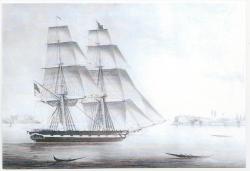The Drews and the Pierces
Among the first settlers to arrive in what is now Hallowell were shipbuilders from southern New England who soon realized that all you needed to build ships on the Kennebec was a stand of timber, a sloping bank and a little good water.

Hallowell-built "Topaz," 1828
Hubbard Free Library
In 1799, William Drew came to Hallowell from Kingston, Massachusetts where family members had built ships for over 160 years. William and his son Allen settled in East Hallowell, known today as Chelsea, and continued the family craft. Allen’s special talent was the carving of ships’ figureheads. The family of Allen and Charity (Pierce) Drew included five sons, three of whom were lost at sea as young men. One, Captain John Drew, adopted the pen name “Kennebecker” and for 17 years wrote a popular column about life at sea for the Boston Journal.

E. Pierce Darting Gun (Harpoon), Hallowell, 1865
Hubbard Free Library
Ebenezer Pierce, a master shipwright, came from the New Bedford area and built ships for New Bedford and Nantucket whaling interests. His son, E.G. Pierce, built many fine ships on the Kennebec, and another son, Eben, in 1865 invented one of the deadliest whaling weapons ever devised, the “bomb lance” harpoon.
In 1852, another son, Captain Job Pierce, built the whaling ship “Lively” in Chelsea. On its way home from its maiden voyage it was lost off Bermuda, taking the lives of the entire crew, including William Drew, age 15, and Charles Pierce, the son of E. G. Pierce, age 21.